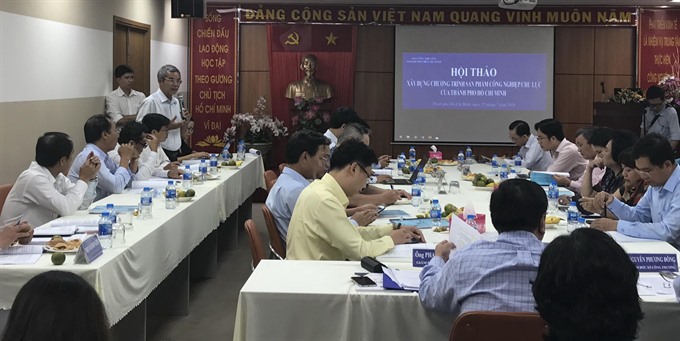 Economy
Economy

The HCM City Department of Industry and Trade met with more than 30 experts at a meeting in the city yesterday to discuss ways to develop the city’s main industrial products.
 |
| Delegates at a meeting in HCM City discuss solutions to develop the city’s key industrial products. — VNS Photo |
HCM CITY — The HCM City Department of Industry and Trade met with more than 30 experts at a meeting in the city yesterday to discuss ways to develop the city’s main industrial products.
Speaking at the meeting, the department’s deputy director Nguyễn Phương Đông said the city’s economic growth rate had risen greatly in recent years, but its development capacity had encountered shortcomings.
He said that competitiveness was not that high, infrastructure had degraded, and land rentals remained rather high compared to other localities.
Added value to products also remains low, and key products have not been clearly identified, according to Đông.
Lý Thị Kim Chi, chairwoman of the HCM City Food and Foodstuff Association, said in the city only some of the 15 major industrial products selected before 2015 were still available in the market, while others had disappeared due to competitive pressure.
The city resumed its programme on selecting major industrial products, but selection criteria should be reviewed to fit the current situation, she said.
There were many products of high added value, with a large market share in domestic market and exports, but they did not met the programme’s selection criteria, she added.
Nguyễn Văn Hùng, chairman of the 28 Corporation, said the city should have a long-term vision to serve as a basis for identification of key products.
As for the garment and textile sector, it is unlikely to remain in HCM City due to the factors of labour, wages, infrastructure and logistics, among others.
Though garment and textile products would not be the city’s key products in the long term, there should be a centre for designing and logistic services, he said.
According to participants, big branded products in the city are gradually losing market advantage, with some producers shifting to produce goods in other localities.
Since it was now becoming more difficult to identify key products, the city needed to have a multi-dimensional approach to the problem, they said.
If the criteria for selecting key products is based on size and market growth, the product will have a high risk because there is high potential for market fluctuation.
Trần Quốc Toản, general director of the Saigon Transportation Mechanical Corporation (SAMCO), said the city’s key products should focus on downstream products combined with an industry development forecast.
These products must be associated with the city, and at the same time, the city must develop a policy to create market space and opportunities for the key products to develop.
For example, the city is encouraging the production of clean-fuel vehicles, but with this policy, the city must also create ways for organisations and individuals to use the vehicles.
Nguyễn Thị Cành of the University of Economics and Law in HCM City said that it was not necessary to have only high-tech industries or industries with high added value as the main ones, but selection criteria should vary depending on the industry.
Attendees at the meeting also said the city’s key products must be Vietnamese-made products. In addition, the key products must be involved in the city’s activities to promote investment and brand development.
The programme on developing the city’s key industrial products should focus on priority sectors for development, especially the manufacturing sector with high added value, participants said.
The city should have mechanisms to support sectors with high development potential, while support should be done in an indirect way such as developing human resources and new production technology and data systems for the sectors, among others, they said. — VNS




